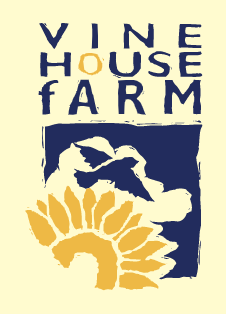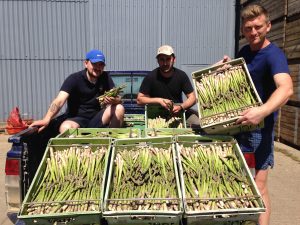
A rather damp July has given us 76mm or 3ins of rain here on the farm. As usual for July, heavy showers have meant totals have varied locally, only six wetter Julys in the last 50 years. Temperatures are 0.8°C above average for the last 50 years, but average for the last 10 years. As national statistics show, we are warming up. On July 25th the temperature was 36.5°C which was the highest I have ever recorded. That night the mercury only dipped to 21°C, which also occurred on August 4th 2004.

Due to the wet summer, our crops are very lush and are in no hurry to ripen. The harvesting of winter barley and rape is taking place in between the showers. Rape crops are poor however, and the winter barley is only producing average yields. This kind of summer is better suited to farms on sandy and gravelly land – the past few summers have been too dry to yield large crops on this type of land.
Oil seed rape crops are not very good due to the cabbage stem flea beetle, which seems to have affected every crop. In the past, we dressed the rape seeds with neonicotinoids which protected the crop from the beetles during the lifetime of the crop. As it disorientates honey bees, the chemical was taken off the market. Whether it disorientated any other insects we don’t know.
No one knows how many flea beetles there will be, but I do know that the acreage of rape will be down this coming year. We shall be sowing our rape early so if the crop fails we will have time to sow another crop.
In wet years, we quite often have a job to control weeds on the organic land but due to the dry weather in May, the weeds are under control. Prices for our organic wheat and barley crops are double that of our conventional crops, and carry an additional premium, because we are growing them for seed. Another 40 acres will have turned organic this autumn and 50 acres this time next year. To grow the crop for seed, it has to be free of wild oats, docks and charlock. Our fields have to be walked twice removing all the plants that cause trouble and then are inspected by NIAB, the National Institute of Agricultural Botany. The combine, the trailers and dryer also have to be cleaned out carefully before we harvest the organic crops.
We have been irrigating the potatoes when they have needed rain but they won’t be irrigated any more this summer as we have now brought all the irrigators out of the fields.
Sugar beet crops will be enjoying the damp weather and there will be some big crops about but there needs to be as we are only getting paid £20/tonne. 15 years ago, before the crop was related to the world sugar price, it was £36/tonne, but now British Sugar say they cannot afford to pay us any more than £20/tonne. We don’t have to grow it – British Sugar seem to be able to get enough farmers to grow it so it must still be a reasonable option. It is a good break crop, totally different to any other crop we grow and that is why farmers still grow it.
The sugar beet crop has seen large increases in yield over the past 20 years, average yields have gone from 20 tonnes/acre to 30 tonnes/acre with some growers on the best land topping 40 tonnes/acre. That is why we can still make a profit from it, but basically, as every year goes by, the profit from an acre of land gets less and less and so if we don’t farm more land we are actually going backwards, we either have to farm more land, diversify or drop out!

Our wildlife has enjoyed the moist summer, certainly we had several Lapwings reared late that wouldn’t have been reared at all if it had been a dry summer. Blackbirds are still pulling worms out of lawns to feed nestlings and that doesn’t happen in a dry time.
Perhaps the biggest winner on the farm have been the Moorhens nesting on the ponds near the farmhouse. In the April newsletter, I talked about my dwindling population of Moorhens – three years ago we would have had 16 Moorhens wintering on the second pond, two years ago there were only 12 and last winter numbers were down to six. Total numbers wintering here do include birds from other ponds.
Not wishing for another species to go extinct from our garden, we built a further floating house on another pond, so that they could build two nests. This means that predators would not be able to see the sitting female in the house. Both nests are on their third brood and those young are all being reared successfully. The first and second broods are helping to raise the third brood in both ponds and so they are being well looked after.
A week ago, a nest was built outside the floating house on the edge of the pallet. This was used for brooding the latest young birds from the third brood, mainly at night and when it was raining. The net result is that we have more than 16 Moorhens to winter with us so building them another floating house definitely helped.
I am sure that everyone in the village will have heard a Cuckoo around this summer and I thought I would find eggs in several Reed Warbler nests, and I found over 50 nests. However, I only found one nest with a Cuckoo’s egg in it, and once it hatched it ejected the other Reed Warbler eggs the nest contained, to ensure its own survival.
In the past, young Cuckoos have had a very poor survival rate as they get too heavy and in windy weather the reeds or the nest give way. The young Cuckoo lands in the water and cannot survive. I kept a close eye on this one, especially as it was well up in the reeds, I put the nest in a wire cradle and bunched several reeds together. The Cuckoo hatched on July 9th and fledged on July 29th, which was the day before the windy weather arrived. Its foster parents had to work extra hard as it was in the nest for eight days longer than a brood of Reed Warblers would have been.
I was asked whether I should have saved the Reed Warbler eggs or taken the young Cuckoo out of the nest but to me this is an example of evolution at its best. How could it have evolved and how long would it have taken to evolve? It is absolutely amazing and the way that the Cuckoo manages its migration, stopping to fatten up in various places before it crosses the Sahara and the Mediterranean, how does it know to do that? Just mind blowing. It is diversity at its finest.
Don’t forget to look us up at the bird fair, I will be attending all three days and we will be on our usual stand. Our trailer for seed collection will be in the red car park.
TALKS & EVENTS
16th – 18th August: The Bird Fair at Rutland
Waters – we’ll be there on our usual stand, do
come & see us!



